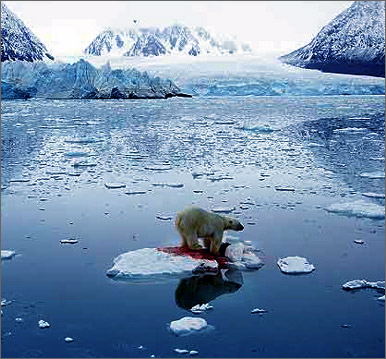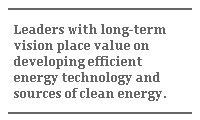The Planet in Peril – Part II
The Planet in Peril – Part II

NEW YORK: The threat to the planet from global warming is clear. Fortunately, so are the solutions. Despite what naysayers claim – that energy-use patterns cannot be altered to any great extent – real change is possible given the political will to enact it. If such change is not enacted, however, pessimistic prophecies become self-fulfilling, especially with government subsidies and intensive efforts by special-interest groups to prevent the public from becoming well-informed.
In reality, an alternative scenario is possible – and the US could take the lead. In response to oil shortages and price rises in the 1970s, the US controlled its energy use by requiring an increase from 13 to 24 miles per gallon in the auto-efficiency standard. Economic growth was decoupled from growth in the use of fossil fuels, and the efficiency gains were felt worldwide. Global growth of CO2 emissions slowed from more than 4 percent each year to between 1 and 2 percent growth each year.

The US maintained the slower growth rate despite lower energy prices. Yet the US is only half as efficient in energy use as Western Europe, which encourages efficiency by fossil-fuel taxes. China and India, using older technologies, are less energy-efficient than the US and have a higher rate of CO2 emissions.
Available technologies could improve energy efficiency, even in Europe. Economists agree that the potential could be achieved most effectively by a tax on carbon emissions, although only strong political leadership could persuasively explain the case for such a tax to the public. The tax could be revenue-neutral. Consumers who make a special effort to save energy could gain; well-to-do consumers who insist on three Hummers would pay for their excess.
Achieving a decline in CO2 emissions faces two obstacles: the huge number of vehicles that are inefficient in using fuel, and continuing CO2 emissions from power plants. Automakers oppose efficiency standards, prominently advertising their most powerful vehicles, which yield the greatest short-term profits. Coal companies want new coal-fired power plants built soon, assuring their long-term profits.

The California legislature passed a regulation requiring a 30 percent reduction in automobile greenhouse gas emissions by 2016. If adopted nationwide, this regulation would save more than $150 billion annually in oil imports. By fighting it in court, automakers and the Bush administration have stymied the California law, which many other states stand ready to adopt.
The world must delay construction of new coal-fired power plants until the technology needed to sequester CO2 emissions is available. In the interim, new electricity requirements should be met with renewable energies. Much could be done to limit emissions by improving fuel-efficiency standards in buildings and appliances. Such improvements are entirely possible, but require strong leadership.
The Kyoto Protocol encouraged developed countries to decrease emissions slowly early in this century and extended help to the developing countries for adopting "clean" energy technologies that limit the growth of their emissions. Delays in that approach – especially US refusal to participate in Kyoto and improve vehicle and power-plant efficiencies – and the rapid growth in the use of dirty technologies resulted in an increase of 2 percent per year in global CO2 emissions during the past ten years. If such growth continues another decade, emissions in 2015 will be 35 percent greater than they were in 2000.
Any responsible assessment of environmental impact must conclude that further global warming exceeding 2 degrees Fahrenheit is dangerous. Yet because of the warming bound to take place, from continuing long-term effects of greenhouse gases and energy systems now in use, the world will exceed the 2-degree limit unless a change in direction begins this decade.

The public can act as our planet's keeper. The first human-made atmospheric crisis emerged in 1974, when chemists reported that chlorofluorocarbons (CFCs) might destroy the stratospheric ozone layer that protects the Earth from the sun's ultraviolet rays. How narrowly we escaped disaster was not realized until years later.
Production of the useful aerosol propellant, fire suppressor and refrigerant fluid increased 10 percent per year for decades. If this business-as-usual growth of CFCs had continued just one more decade, it would have caused a larger greenhouse effect than CO2.
Instead, the media reported chemists’ warning, and consumers boycotted frivolous use of CFCs as propellants for hairspray and deodorant. Annual growth of CFC usage plummeted to zero. The principal CFC manufacturer developed alternatives. When the use of CFCs for refrigeration began to increase and a voluntary phaseout of CFCs proved ineffective, the US and European governments took the lead in negotiating the Montreal Protocol to control CFC production. Developing countries received financial assistance to construct alternative chemical plants. As a result, CFC use is decreasing. The ozone layer will recover.
Yet the same scientists and political forces that succeeded in controlling the threat to the ozone layer now fail in controlling the global-warming crisis. There is plenty of blame to go around: Scientists present facts about climate change clinically, failing to stress that business-as-usual will transform the planet. The media, despite overwhelming scientific consensus concerning global warming, give equal time to fringe "contrarians" supported by the fossil-fuel industry. Special-interest groups mount disinformation campaigns, sowing doubt. The government fails to provide leadership.

Leaders with a long-term vision would place value on developing efficient energy technology and sources of clean energy. Rather than subsidizing fossil fuels, the government should provide incentives for companies to develop alternatives. Instead, politicians cast policies that favor short-term profits of energy companies as providing jobs, in the best economic interests, taking no account of the mounting costs of environmental damage or future costs of maintaining the fossil-fuel supply.
Today’s leaders won’t pay for the tragic effects of a warming climate. If we pass the crucial point, history will judge harshly the scientists, reporters, special interests and politicians who failed to protect the planet. But our children will pay the consequences.
The US has heavy legal and moral responsibilities for global warming – and cannot claim to be ignorant of the consequences. Of all the CO2 emissions produced from fossil fuels so far, the US is responsible for almost 30 percent. Runners-up China and Russia each have less than 8 percent.
By refusing to participate in the Kyoto Protocol, the US delayed implementation and weakened its effectiveness, undermining international attempts to slow emissions of developed countries.
It is not too late. The world has at most ten years to alter the trajectory of global greenhouse emissions. If we follow an energy-intensive path of squeezing liquid fuels from tar sands, shale oil and heavy oil, and do so without capturing CO2 emissions, climate disasters are unavoidable.
A good energy policy, economists agree, is not difficult. Fuel taxes should encourage conservation. With slow, continual increases of fuel cost, energy consumption will decline without harming the economy. Quality of life need not decline.
The world needs politicians with courage to explain what is needed. Indeed, Al Gore, with his movie and book of the same name, “Inconvenient Truth,” was prescient. For decades he maintained that the Earth teeters in the balance, even when doing so subjected him to ridicule. By telling the story of climate change with striking clarity, Gore may have done for global warming what “Silent Spring” did for pesticides. He is under attack, but the public now has the information needed to distinguish our long-term well-being from short-term special interests.
Perhaps the country came close to having the leadership it needed to deal with a grave threat to the planet, but did not realize it.
Jim Hansen is director of the NASA Goddard Institute for Space Studies and adjunct professor of earth and environmental sciences at Columbia University’s Earth Institute. A longer version of this article was published by “The New York Review of Books.”